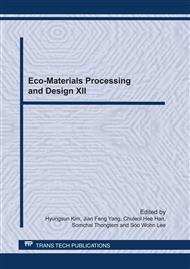p.93
p.97
p.101
p.105
p.109
p.113
p.117
p.121
p.129
Comparison of Sonochemistry Method and Sol-Gel Method for the Fabrication of TiO2 Powder
Abstract:
Sol-gel with sonochemical process and sol-gel method were used for the fabrication of photocatalytic TiO2 powder and the properties of the TiO2 powder thus prepared were examined and compared. For the synthesis of TiO2 powder, the starting material was Ti-butoxide and H2O and the reaction was carried out at 80 °C in a sol-gel method. On the other hand, Ti-butoxide was reacted with H2O in an ultrasonic frequency of 23 kHz with ultrasonic powers of 800 W for two hours. After evaporation, 24 hours aging time was kept at 400 °C in both cases, the final product appeared was the anatase phase. Ultrasonic chemical method was found to be excellent for flocculation and crushing effects where as in sol-gel method, the product obtained was of high purity and high homogeneity. Sol-gel with sonochemical process has found to be excellent for flocculation and crushing effects. From Sol-gel method, the size of TiO2 particles produced were found to be about 20 nm, spherical, homogeneous while severe agglomeration. In contrast, by sonochemistry method, the size of TiO2 particles produced were about 10 ~ 22 nm size and it has shown more photocatalytic activity than sol-gel sample which is about 28.7 % greater efficiency
Info:
Periodical:
Pages:
109-112
Citation:
Online since:
July 2011
Authors:
Keywords:
Price:
Сopyright:
© 2011 Trans Tech Publications Ltd. All Rights Reserved
Share:
Citation:


